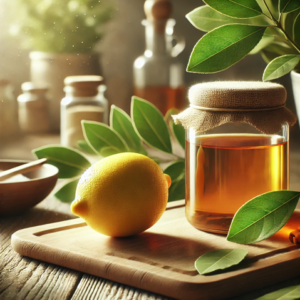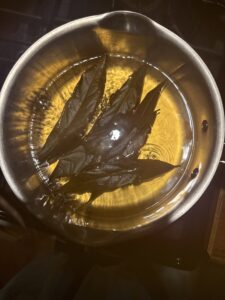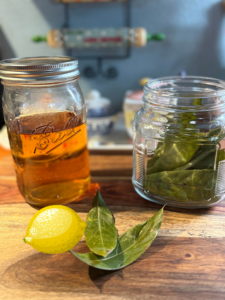Tags
bay leaf cooking, bay leaf medicinal, bay leaf tea, bay leaves, digestive health, honey, lemon, pain relief, respiratory benefits, tea infusions
Bay leaves, scientifically known as Laurus nobilis, are one of the most ancient and versatile herbs in the culinary world. Although often used sparingly in cooking, their deep, aromatic flavor plays a significant role in enhancing a wide variety of dishes, from soups and stews to sauces and roasts. While I use the leaves in cooking, I mostly use the bay leaves to make tea when I am sick.
We have a bay leaf tree growing in our yard, and my husband picks the leaves, washes them, and puts them on a towel to dry. Later in the article, I will share how I make bay leaf tea.

What Are Bay Leaves?
Bay leaves come from the Laurus nobilis tree, a perennial shrub native to the Mediterranean region. The tree produces aromatic, evergreen leaves that can be used fresh or dried. While fresh bay leaves have a milder flavor, dried bay leaves are more commonly used in cooking because they release their oils more effectively during the cooking process.
Bay leaves are known for their sharp, slightly bitter taste with hints of herbal, floral, and earthy flavors. They’re rarely eaten directly because of their tough texture but are often used to infuse flavor into dishes during cooking. Once the dish is done, the bay leaves are typically removed before serving.
Medicinal Uses of Bay Leaves
Medicinal Uses of Bay Leaves: Nature’s Healing Herb
Bay leaves, Laurus nobilis, are not only prized in the kitchen for their flavor but also for their medicinal properties. Used for centuries in various cultures, bay leaves are believed to offer numerous health benefits, thanks to their rich content of essential oils, antioxidants, and compounds like eugenol, which have anti-inflammatory and antimicrobial effects.
1. Digestive Health: Bay leaves have been traditionally used to relieve indigestion, bloating, and flatulence. The compounds in bay leaves can stimulate the production of digestive enzymes, improving overall digestion. Drinking bay leaf tea or using bay leaves in cooking may help soothe an upset stomach and promote better gut health.
2. Respiratory Benefits: Bay leaves are known to possess expectorant properties, making them effective in alleviating symptoms of coughs, colds, and bronchial issues. The essential oils in bay leaves can help clear mucus from the respiratory tract, making breathing easier. Inhaling the steam from bay leaf tea or boiling bay leaves may provide relief from congestion.
3. Pain Relief: Bay leaves are often used as a natural remedy for joint pain and arthritis. Their anti-inflammatory properties can reduce swelling and discomfort when applied as an infused oil or topical treatment.
Incorporating bay leaves into your health routine—whether through teas, infusions, or topical applications—can offer natural relief and enhance overall well-being.
How to make bay leaf tea*
- Fill a pot with 1.5 quarts of water, bring to a boil
- Turn down to a simmer and add 8-10 large bay leaves
- Simmer until the water turns to a medium color
- Pour into a cup and add honey and lemon to taste
- The remainder can either be simmered for a second cup or placed in a mason jar to cool. Once cooled, top with a metal lid. Will keep for up to two days on counter.


Culinary Uses of Bay Leaves
Bay leaves are one of those essential ingredients that can elevate your dishes without requiring much effort. Their unique flavor makes them a key component in many traditional recipes, especially in Mediterranean, Indian, and Middle Eastern cuisines.
Flavor Profile
Bay leaves have a subtle but distinct flavor. The primary taste notes are:
- Earthy: A grounding flavor that complements rich, savory dishes.
- Floral: A light, sweet undertone that adds complexity to soups and sauces.
- Slightly Bitter: This bitterness balances out the richness of meats and stews.
Bay leaves work particularly well when simmered in liquids, as their oils infuse the surrounding ingredients with their unique flavor.
When and How to Use Bay Leaves*
- Soups and Stews: Bay leaves are commonly added to broths, stocks, soups, and stews. The long cooking time allows the leaves to impart their full flavor.
- Rice and Grains: Adding a bay leaf to rice or other grains during cooking can infuse the dish with subtle flavor.
- Slow-Cooked Meats: Bay leaves are often used in braised dishes like pot roast, osso buco, and pulled pork to add depth to the flavor profile.
- Tomato-Based Dishes: Bay leaves pair wonderfully with tomatoes, which is why they’re commonly found in marinara sauces and other tomato-based recipes.
- Pickling: The herb is sometimes included in pickling brines for its subtle spice.
Common Dishes That Feature Bay Leaves
- Minestrone Soup
- Chicken or Beef Stew
- Biryani
- Roast Lamb or Pork
- Gumbo
- Tomato Sauce
- Marinades and Brines
